41474
Levulinic acid
analytical standard
Synonim(y):
4-Oxopentanoic acid, 4-Oxovaleric acid
About This Item
Polecane produkty
klasa czystości
analytical standard
Poziom jakości
ciśnienie pary
1 mmHg ( 102 °C)
Próba
≥97.5% (GC)
97.5-102.5% (T)
okres trwałości
limited shelf life, expiry date on the label
metody
HPLC: suitable
gas chromatography (GC): suitable
tw
245-246 °C (lit.)
mp
30-33 °C (lit.)
gęstość
1.134 g/mL at 25 °C (lit.)
Zastosowanie
cleaning products
cosmetics
flavors and fragrances
food and beverages
personal care
format
neat
ciąg SMILES
CC(=O)CCC(O)=O
InChI
1S/C5H8O3/c1-4(6)2-3-5(7)8/h2-3H2,1H3,(H,7,8)
Klucz InChI
JOOXCMJARBKPKM-UHFFFAOYSA-N
Szukasz podobnych produktów? Odwiedź Przewodnik dotyczący porównywania produktów
Powiązane kategorie
Opis ogólny
Zastosowanie
for the quantification of the analyte in the following:
- Soy sauce using liquid chromatography coupled to mass spectrometry (LC–MS).
- Liquid food samples using gas chromatography with flame ionization detection (GC-FID).
Hasło ostrzegawcze
Danger
Zwroty wskazujące rodzaj zagrożenia
Zwroty wskazujące środki ostrożności
Klasyfikacja zagrożeń
Acute Tox. 4 Oral - Eye Dam. 1 - Skin Sens. 1
Kod klasy składowania
13 - Non Combustible Solids
Klasa zagrożenia wodnego (WGK)
WGK 2
Temperatura zapłonu (°F)
208.4 °F - closed cup
Temperatura zapłonu (°C)
98 °C - closed cup
Wybierz jedną z najnowszych wersji:
Masz już ten produkt?
Dokumenty związane z niedawno zakupionymi produktami zostały zamieszczone w Bibliotece dokumentów.
Klienci oglądali również te produkty
Nasz zespół naukowców ma doświadczenie we wszystkich obszarach badań, w tym w naukach przyrodniczych, materiałoznawstwie, syntezie chemicznej, chromatografii, analityce i wielu innych dziedzinach.
Skontaktuj się z zespołem ds. pomocy technicznej







